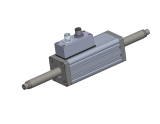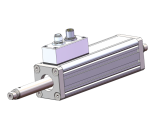Linear motor actuators
TECHNICAL DESCRIPTION:
These devices are, in fact, electric servomotors, intended for linear direct drive of machine elements and technological lines, where high speeds of movement, dynamics, precision and frequent or dynamic reconfiguration of the movement trajectory (on-line) are required. In such situations, the linear motor is an excellent alternative to pneumatic actuators or electric drives with ball screw or drive belt. The motor is characterized by high reliability and low wear during operation. It does not require special lubrication or seals and the involvement of maintenance services is much lower compared to other types of linear drive. No need to connect compressed air makes it much easier to maintain the cleanliness regime in cleanrooms.
The motor consists of two main elements: a forcer with windings, electrical connections, a position sensor and a sliding shaft filled with permanent magnets, which works concentrically with the forcer. The working load can be attached to the moving shaft (the forcer is permanently attached to the machine) or to the forcer (the shaft is stationary and the forcer moves).
A non-contact linear encoder is built in the motor, which provides a feedback signal for control systems in the sin/cos 1Vpp standard and thermal overheating protection.
To supply and control the motor, a properly configured servo amplifier is required, which accepts the feedback signal and ensures that the parameters required by the motor are achieved. The servo amplifier can come from any manufacturer, as long as it meets the requirements of the motor.
EXAMPLE APPLICATIONS:
- packaging machines,
- dosing machines,
- pick & place systems,
- automatic assembly,
- feeders and manipulators,
The visualization of the operation of the linear motor: (e.g. a system of two motors cutting lasania into specific sections)
And here is the actual movement imitating the lasagne cut (the moving ribbon of lasagne and the cutting blade itself need to be imagined)
The video shows a set of two linear motors making the "flying blade" movement moving along with the material cut into portions, and after cutting it, there is a gentle tug pushing the cut piece away from the next one. For example, it may be the portioning of lasagne or curd on the processing line. The dial gauge visible in the video does not take part in this process, but is the equipment of the demonstration stand to show positioning precision, which can be seen in the next video.
In turn, the video below shows the accuracy, repeatability and dynamics of linear motors.
Firstly, the moving shaft gently and precisely touches the indicator tip, followed by two cycles of three quick and dynamic movements. The dial gauge visible in the video has a resolution of 10 microns per division.
Motors can be made in various versions, details of individual models are below:




